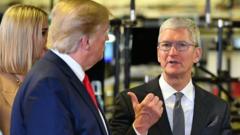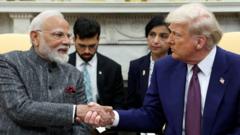The extension provides a temporary reprieve for businesses as trade talks continue amidst ongoing tensions.
Trade Truce Extended Between U.S. and China to Avert Tariff Increases

Trade Truce Extended Between U.S. and China to Avert Tariff Increases
U.S. and China agree to another 90-day halt on tariff hikes, allowing more time for trade negotiations.
The United States and China have agreed to extend their trade truce for an additional 90 days, following a tense period that nearly resulted in substantial tariff increases. Just hours before tariffs were slated to rise, U.S. President Donald Trump signed an executive order on Monday to maintain the current suspension until November 10. This decision was mirrored by Beijing, meaning that the U.S. will continue imposing a 30% tariff on Chinese imports, while China will maintain a 10% tariff on American goods.
This extension comes after Washington had previously floated the idea of imposing tariffs as high as 145% on Chinese products, prompting China to respond with its own 125% duties on American exports. Fortunately, a round of trade talks held in Geneva in May helped scale back these rates. The latest pause is intended to foster further discussions focused on "remedying trade imbalances" and addressing "unfair trade practices," according to a White House statement that highlighted a significant trade deficit of nearly $300 billion with China in 2024, the largest among all U.S. trading partners.
Both sides are expected to negotiate to improve access for U.S. exporters to China and tackle key economic and national security challenges. A spokesperson from the Chinese embassy emphasized the importance of collaborative efforts between the two nations, stating that cooperation yields benefits, while suppression and containment do not. China has also urged the U.S. to eliminate what it deems unreasonable trade restrictions and to collaborate more effectively to stabilize global semiconductor production.
The uncertainty caused by the ongoing tariff discussions remains a concern for businesses. Beth Benike, founder of Busy Baby, expressed frustration, stating that the lack of clarity regarding future tariffs disrupts her ability to plan for her business.
With trade tensions escalating in April, when Trump announced broad tariffs on international goods that targeted China particularly harshly, Beijing retaliated, leading to a damaging back-and-forth that threatened to paralyze trade relations. Some of these tariffs were temporarily suspended following negotiations in May, resulting in the current tariff structure.
As negotiations continue, issues such as access to China's rare earth minerals, its imports of Russian oil, and U.S. restrictions on advanced technology exports, particularly semiconductors, remain on the table. Recently, Trump eased some export restrictions, allowing U.S. firms like AMD and Nvidia to resume certain chip sales to Chinese companies, contingent on a revenue-sharing agreement with the U.S. government. This arrangement has faced criticism, with some labeling it a flawed practice.
The U.S. also maintains its push for TikTok to separate from its Chinese parent company, ByteDance, a move met with resistance from Beijing. On Monday, Trump hinted at optimism regarding negotiations, although he refrained from committing to further extensions of the truce. Meanwhile, U.S. import figures reveal a significant decrease in trade, showing that U.S. imports from China plummeted nearly 50% in June compared to the previous year, while American exports to China witnessed a decline of approximately 20% within the same timeframe.
This extension comes after Washington had previously floated the idea of imposing tariffs as high as 145% on Chinese products, prompting China to respond with its own 125% duties on American exports. Fortunately, a round of trade talks held in Geneva in May helped scale back these rates. The latest pause is intended to foster further discussions focused on "remedying trade imbalances" and addressing "unfair trade practices," according to a White House statement that highlighted a significant trade deficit of nearly $300 billion with China in 2024, the largest among all U.S. trading partners.
Both sides are expected to negotiate to improve access for U.S. exporters to China and tackle key economic and national security challenges. A spokesperson from the Chinese embassy emphasized the importance of collaborative efforts between the two nations, stating that cooperation yields benefits, while suppression and containment do not. China has also urged the U.S. to eliminate what it deems unreasonable trade restrictions and to collaborate more effectively to stabilize global semiconductor production.
The uncertainty caused by the ongoing tariff discussions remains a concern for businesses. Beth Benike, founder of Busy Baby, expressed frustration, stating that the lack of clarity regarding future tariffs disrupts her ability to plan for her business.
With trade tensions escalating in April, when Trump announced broad tariffs on international goods that targeted China particularly harshly, Beijing retaliated, leading to a damaging back-and-forth that threatened to paralyze trade relations. Some of these tariffs were temporarily suspended following negotiations in May, resulting in the current tariff structure.
As negotiations continue, issues such as access to China's rare earth minerals, its imports of Russian oil, and U.S. restrictions on advanced technology exports, particularly semiconductors, remain on the table. Recently, Trump eased some export restrictions, allowing U.S. firms like AMD and Nvidia to resume certain chip sales to Chinese companies, contingent on a revenue-sharing agreement with the U.S. government. This arrangement has faced criticism, with some labeling it a flawed practice.
The U.S. also maintains its push for TikTok to separate from its Chinese parent company, ByteDance, a move met with resistance from Beijing. On Monday, Trump hinted at optimism regarding negotiations, although he refrained from committing to further extensions of the truce. Meanwhile, U.S. import figures reveal a significant decrease in trade, showing that U.S. imports from China plummeted nearly 50% in June compared to the previous year, while American exports to China witnessed a decline of approximately 20% within the same timeframe.



















